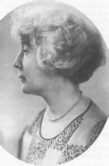May Howard Jackson
| May Howard Jackson | |
|---|---|
 | |
| Born |
September 7, 1877 Philadelphia |
| Died | 1931 |
| Nationality | African American |
| Known for | Sculptor |
| Spouse(s) | William Sherman Jackson |
| Awards | Harmon Foundation, 1928 |
May Howard Jackson (September 7, 1877–1931) was an African-American sculptor.[1]
She was known as "one of the first black sculptors to ... deliberately use America's racial problems" as the theme of her art.[2]
Early life and career
May Howard Jackson was born and grew up in Philadelphia, which had a large and well-established black community. She was a student at J. Liberty Tadd's art school there and in 1895 became the first African American to receive a scholarship to attend The Pennsylvania Academy of the Fine Arts.
She married a school principal, and moved to Washington, D.C. in 1902. She became a sculptor of portraits, and taught at Howard University.[3] She did not travel to Europe to study and as a result was somewhat isolated from her peers. This allowed her to create her own vision and infused her work with a unique style. Her portraits were at first ignored, as they were not realistic in the cameo style popular at the time.
They were provocative for expressing the features of the multi-racial in American society. for centuries Europeans and Africans had formed unions and marriages. She was fascinated with the wide variety of features among African Americans. Her works such as Head of a Negro Child 1916, Mulatto Mother and Her Child 1929, and Shell-Baby in Bronze 1929[4] took up this theme in her abstracts and defined her sculptures.
Few galleries were willing to offer her exhibition space. With legal racial segregation and disenfranchisement of most blacks having been in force across the South since the turn of the century, topics such as racial mixing were taboo in general. Laws against miscegenation had been proposed in both federal and state legislatures after Democrat Woodrow Wilson was elected as President in 1912.
As a sculptress, Jackson was accomplished enough to be counted among the pantheon of great American sculptors. May Howard Jackson died in 1931.[5] She is interred at Woodlawn Cemetery in The Bronx, New York City.
Review
The Crisis, Vol. 12, No. 3, July 1916.[6]
Mrs May Howard Jackson, Veerhoff Gallery, Washington, DC. From the Washington Star, "Of the three works reviewed, …touching upon the mysteries of heredity in a way which is exceedingly striking” Adding: “her work has always shown promise, but these pieces now on exhibition indicate exceptional gift, for they are not merely well modeled, but individual and significant.” [7]
Selected works
- Paul Lawrence Dunbar (Dunbar High School, Washington D.C.).[8]
- W.E.B. Du Bois
- Dean Kelly Miller (1914, Howard University)[9]
- Head of a Negro Child (1916).[10]
- Bust of a Young Woman (n.d., plaster, held by Howard University) [3]
- Baby in a Shell.[11]
- Slave boy.[12]
Exhibitions
- The New York Emancipation Exhibition (1913)
- The Corcoran Art Gallery (1915)
- The National Academy of Design (1916)
- The Veerhoff Gallery, Washington D.C. (1916) [3]
References
- ↑ http://www.aaregistry.org/aareg_files/event_images/MayHowardJackson.gif
- ↑ Arna Alexander Bontemps and Jacqueline Fonvielle-Bontemps (eds.), eds. (2001). "African-American Women Artists: An Historical Perspective". Black Feminist Cultural Criticism. Keyworks in cultural studies. Malden, Mass: Blackwell. pp. 133–137. ISBN 0631222391.
- 1 2 3 Rubinstein, Charlotte Streifer (1990). American Women Sculptors: A History of Women Working in Three Dimensions. Boston, MA: G.K. Hall. ISBN 0816187320.
- ↑ "May Jackson (1877 - 1931)", askArt.
- ↑ Darlene Clark Hine (ed.), Black Women in America: An Historical Encyclopedia, Vols 1 and 2, Carlson Publishing Inc., Brooklyn, New York, 1993. ISBN 0-926019-61-9.
- ↑ "Letter from W. E. B. Du Bois to May Howard Jackson, March 14, 1929", Credo.
- ↑ The Crisis - W. E. B. Dubois, p. 115.
- ↑ https://s-media-cache-ak0.pinimg.com/736x/e3/88/13/e3881301f8d9b25b009405ac8215d67b.jpg
- ↑ https://www.pinterest.com/pin/231583605813021417/
- ↑ https://www.pinterest.com/artzodiac/al-zubra/
- ↑ http://www.askart.com/photos/SWN20130214_75847/4.jpg
- ↑ "Slave Boy, 1899, Mary Howard Jackson, 21×21.5, Bronze", Lafayette.
External links
- "A great sculptor ahead of her time, May Jackson". African American Registry. Retrieved 2014-11-01.